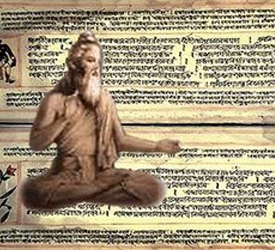Vedo Rakshati Rakshitaha

Vedic Concepts
Veda is divided into four major parts viz, Samhitas (prayers), Brahmanas (rituals), Aranyakas ( meditations) and Upanishads (The knowledge of self). The first three (Samhita, Brahmana & Aranyaka) are collectively called as Veda Purva (Starting) and the last one Upanishad is called as Veda Anta (ending) or Vedanta. The Veda Purva is also referred as Karma Kanda (Portion dealing with Rituals & Activities) and Vedanta as Jnana Kanda (Portion dealing with The Knowledge of Supreme Self).
Vedic Meditation
Vedic meditation is over 5,000 years old; its origins are in India. Learning Vedic Meditation is relatively simple. The initiate is given a mantra by a teacher or guru. The mantra has no inherent meaning but is only a sound used silently (not spoken or chanted) in the mind to induce a relaxed, non-thinking state. The meditator practices twice a day – once in the morning and once in the evening – for 20 minutes in a comfortable upright position. There is no demand on the meditator to change his/her lifestyle in any way save that nothing interferes with his/her daily practice. Vedic Meditation teachers teach independently of any formal or proprietary organisation. Vedic Meditation has been gaining in popularity in recent years, as some consider it to be a generic brand of Transcendental Meditation.
Scientifically proven benefits: Meditators experience a state of deep relaxation during practice of the technique that helps to dissolve stress over time.Leading medical experts report that 90% of all disease is caused or complicated by stress.A few of the benefits experienced by people who practice Vedic Meditation regularly include:
Lower Blood Pressure
Relief from Insomnia
Better Immune System
Reduced Anxiety
Fewer Infections
Normalization of Body Weight
Vedic Meditation is a simple, natural technique practiced sitting comfortably with eyes closed for 15-20 minutes, twice a day. And absolutely anyone can learn the technique in just four short sessions. So, why would anyone want to learn? Because Vedic Meditation does two things really well. First, it helps you achieve a profoundly deep state of restfulness, demonstrated to be 3 to 5 times deeper than sleep. This deep rest gained on a daily basis rejuvenates and restores your entire system and allows you to release years of accumulated stress.Second, at the same time as the body is enjoying this deep state of rest, the mind effortlessly settles down to quieter and quieter states of awareness until you transcend the field of thought completely to have a direct experience of your most essential self, of the “you” that lies beyond all your thoughts and stress and struggles. It feels great. You emerge rested and energized and, at the same time, grounded. And that’s only the beginning.
